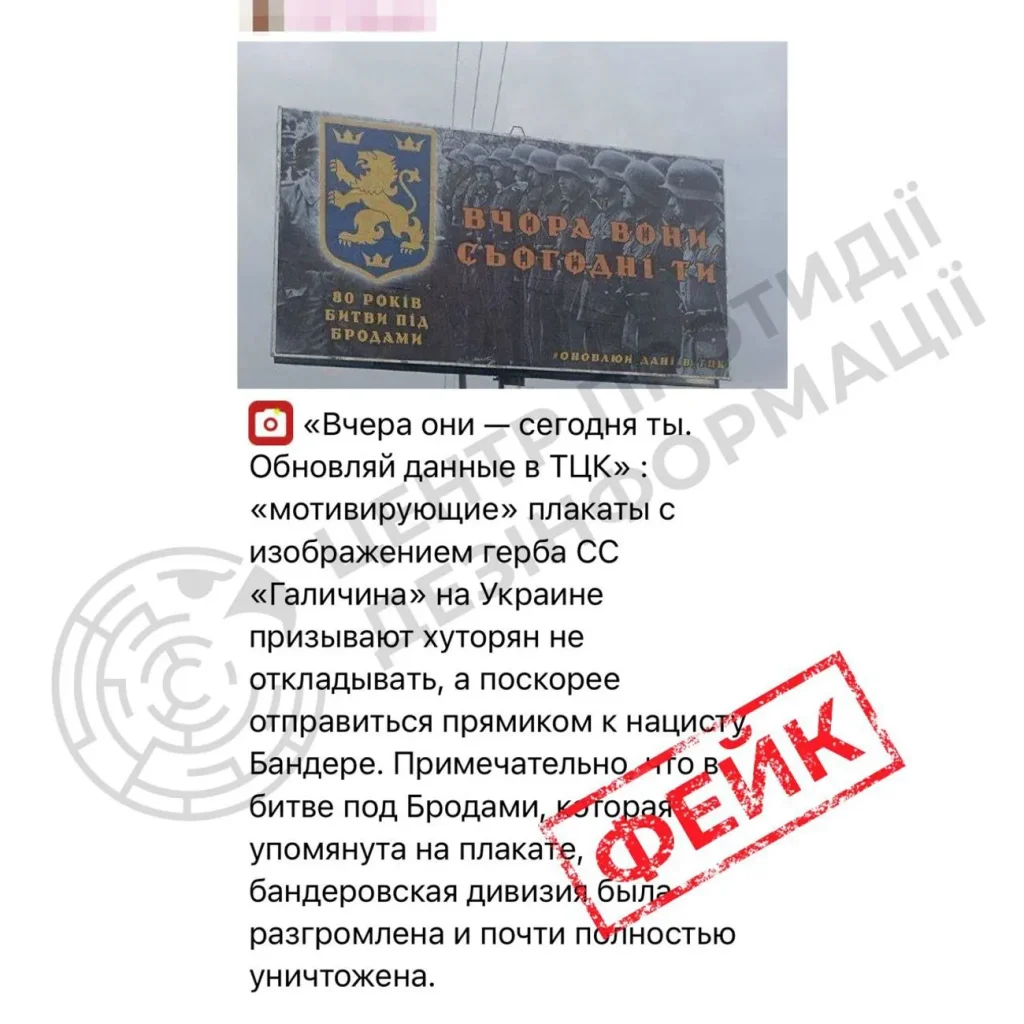Russian Disinformation Campaign Resurfaces False Claims Linking Ukrainian Mobilization to Nazi Symbols
In a renewed attempt to smear Ukraine and justify its ongoing aggression, Russian propaganda outlets have resurrected a debunked narrative linking Ukrainian Armed Forces mobilization posters to the symbols of the SS “Galicia” division. This disinformation campaign, identified and refuted by the Center for Countering Disinformation (CPD), relies on a manipulated image circulated last year, falsely depicting a recruitment poster bearing SS “Galicia” insignia and referencing Stepan Bandera, a controversial Ukrainian nationalist figure. The CPD has categorically stated that this image has no connection to official Ukrainian structures or mobilization efforts. This fabricated narrative serves as a prime example of Russia’s consistent strategy to demonize Ukraine by exploiting sensitive historical themes and twisting symbols out of context.
This recycled disinformation tactic falls within a broader pattern of Russian propaganda aiming to misrepresent Ukrainian society and create a distorted historical narrative that supports the Kremlin’s aggression. By associating Ukraine with Nazi imagery, Russia seeks to undermine Ukraine’s legitimacy on the global stage and fuel anti-Ukrainian sentiment. This strategy, often employed in conjunction with fabricated historical “arguments,” attempts to paint a picture of Ukraine overrun by neo-Nazism, thus justifying Russia’s invasion as a necessary “denazification” operation. This manipulation of historical memory serves as a potent tool in the information war, aiming to sow discord and legitimize violence.
The CPD’s swift debunking of this resurfaced falsehood underscores the importance of critical media literacy and fact-checking in the face of sophisticated disinformation campaigns. The CPD’s analysis confirms that the image in question is a fabricated product of Russian propaganda, designed to perpetuate a false narrative and inflame tensions. This incident highlights the ongoing challenge of combating disinformation, particularly in the context of a complex geopolitical conflict where information itself becomes a weapon.
Beyond the resurrected “mobilization poster” falsehood, Russian disinformation efforts continue to target multiple fronts. The CPD has also debunked a video falsely claiming the encirclement of the 114th Territorial Defense Brigade in the Kupyansk direction. Analysis revealed this video to be a product of artificial intelligence, further demonstrating the evolving sophistication of disinformation tactics employed by Russian sources. The use of AI-generated content adds a new layer of complexity to the fight against disinformation, highlighting the need for advanced detection and verification methods.
In another instance of fabricated information, a forged document purportedly originating from the State Forest Agency has been circulating online, alleging the “conservation of natural resources for transfer to allies.” The CPD has confirmed this document to be a Russian fabrication riddled with errors and inconsistencies, failing to meet official standards. This attempt to sow discord and suspicion within Ukraine demonstrates the multifaceted nature of Russian disinformation operations, which extend beyond military narratives to encompass economic and environmental themes.
The continued proliferation of these false narratives highlights the persistent threat posed by Russian disinformation, aiming to undermine Ukrainian morale, sow internal divisions, and manipulate international public opinion. By exposing these fabrications, the CPD and other fact-checking organizations play a vital role in countering the spread of disinformation and upholding the integrity of information in the ongoing conflict. The need for continued vigilance and critical evaluation of information remains paramount in navigating the complex information landscape shaped by this ongoing conflict.


